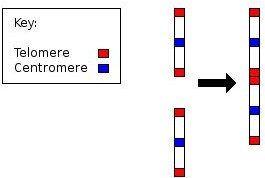DNA Evidence for Evolution: Chromosomes, the Fossil Record & Practical Applications of the Theory of Evolution
Chromosomes and Evolution Evidence
Chromosomes, or the higher order structures that contain genes, are also analyzed to support the theory of evolution. Scientists compare chromosomes among species or other large groups of living organisms and “tally up” the differences. The result is that groups that are less related will have a greater number of structural differences, or rearrangements, in their chromosomes. An extremely important piece of chromosomal evidence for evolution was discovered in 2005. It was observed that our closest relatives, chimpanzees, gorillas and orangutans, possess 48 chromosomes, or 24 pairs (one pair coming from mom and one coming from dad), while humans possess 46 chromosomes, or 23 pairs.
According to the theory of evolution, because we are so closely related to these apes in genetic terms, the difference in our chromosome numbers must have one of two explanations. Either the human lineage lost a chromosome or there was a fusion between two chromosomes. Losing a chromosome would be out of the question biologically, given the fact that such a huge loss of genetic material would certainly be fatal for an organism. Once scientists started looking for evidence of chromosome fusion, however, they were surprised at how easy it was to find. Indeed, human chromosome 2 is now accepted by scientists as having resulted from the fusion of two ancestral chromosomes, still found in apes; in apes, the original chromosomes are now called 2A and 2B.
Populations
The last level to examine for genetic evidence of evolution is the population level. The modern evolutionary synthesis postulates that there is genetic variation in populations of living organisms and over time, some alleles (or alternative versions of genes) will become more or less prevalent in a population, depending on circumstances. This concept is no more obvious than in the case of antibiotic and pesticide resistance in bacteria and insects. Some bacteria, even before the advent of mass-produced antibiotics, possessed the occasional antibiotic resistance gene. When humans introduced antibiotics on such a massive scale, we “favored” those bacteria which possessed resistance, thereby changing the genetic composition of the bacterial population.
This has also been observed in the laboratory. Dr. Richard Lenski, at Michigan State University, observed that cloned (genetically identical) E. coli actually displayed genetic diversity after 40,000 generations. Furthermore, he placed these bacteria in test tubes full of citrate, which E. coli cannot normally metabolize; after around 30,000 generations, a mutation arose that allowed the bacteria to utilize the citrate as a food source.
Practical Applications of the Theory of Evolution
Not only are these genetic similarities useful for humans in order to support evolution, but they also have a much more practical application for us. Indeed, they are the basis for the use of “model” organisms. Because of the ethics involved in doing experimentation on humans, many other organisms are used to understand basic physiological and disease processes in humans. These model organisms can be successfully used because of the similarities in the gene structure and biochemical processes among living things. Many organisms can also provide insight into how to treat medical illnesses; it is thanks to the ideas of evolutionary theory, for example, that mice have provided so much insight into the study of cancer.
More than Just the Genes
Even though there is a an enormous body of genetic evidence that supports evolution, this evidence is given even more weight because of the corroboration of its conclusions from other scientific disciplines. The fossil record, for example, reflects what the genes tell us. In very broad terms, when comparing DNA sequences, scientists find that humans have more in common with mice than with frogs. The fossil record says that amphibians appeared on Earth way before mammals did, so humans and mice share a more recent common ancestor than do humans and frogs, which explains why they are more genetically similar. All other observations point to the same conclusions.
Go to Part 1
Part 1 of the Genetic Evidence for Evolution
References
The Shape of Life: Genes, Development, and the Evolution of Animal Form (Raff, 1996)
Evolution (Mark Ridley, Ed., 1997)
From DNA to Diversity: Molecular Genetics and the Evolution of Animal Design (Carroll et al., 2001)
Asking About Life (Tobin and Dushek, 2005)
Biology: A Guide to the Natural World (Krogh, 2005)
The Chimpanzee Sequencing and Analysis Consortium. “Initial sequence of the chimpanzee genome and comparison with the human genome.” Nature, 2005.
Your Inner Fish (Shubin, 2009)
https://www.talkorigins.org/faqs/comdesc/section1.html
Images courtesy of Wikipedia
This post is part of the series: The Genetic Evidence for Evolution
In this two-part series we’ll be looking at how molecular biology, from DNA sequences to population genetics, supports the theory of evolution.
